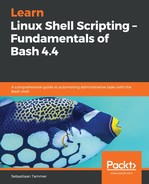On a fresh installation of Ubuntu, the /opt/ directory is empty. While it is again a matter of convention, in our experience, this directory is most often used to install software that comes from outside the distribution's package manager. However, some applications that are installed with the package manager do use /opt/ for their files; it's all a matter of preference by the package maintainer. In our case, we will be using this directory to save the shell scripts we'll be creating, as these definitely classify as optional software.
The /tmp/ directory is used for temporary files (who would have guessed?). In some Linux distributions, /tmp/ is not part of the root partition but mounted as a separate tmpfs filesystem. This type of filesystem is allocated within the RAM, which means the contents of /tmp/ do not survive a reboot. Since we're dealing with temporary files, this is sometimes not only a nice feature, but a prerequisite for particular uses. For a desktop Linux user, this could for example be used to save a note which is only needed during the active session, without having to worry about cleaning it up after you're done.
Finally, the /var/ directory is a little more complex. Let's have a look:
reader@ubuntu:~$ cd /var/
reader@ubuntu:/var$ ls -l
total 48
drwxr-xr-x 2 root root 4096 Jul 29 10:14 backups
drwxr-xr-x 10 root root 4096 Jul 29 12:31 cache
drwxrwxrwt 2 root root 4096 Jul 28 10:30 crash
drwxr-xr-x 35 root root 4096 Jul 29 12:30 lib
drwxrwsr-x 2 root staff 4096 Apr 24 08:34 local
lrwxrwxrwx 1 root root 9 Apr 26 19:07 lock -> /run/lock
drwxrwxr-x 10 root syslog 4096 Jul 29 12:30 log
drwxrwsr-x 2 root mail 4096 Apr 26 19:07 mail
drwxr-xr-x 2 root root 4096 Apr 26 19:07 opt
lrwxrwxrwx 1 root root 4 Apr 26 19:07 run -> /run
drwxr-xr-x 3 root root 4096 Jun 30 18:20 snap
drwxr-xr-x 4 root root 4096 Apr 26 19:08 spool
drwxrwxrwt 4 root root 4096 Jul 29 15:04 tmp
drwxr-xr-x 3 root root 4096 Jul 29 12:30 www
reader@ubuntu:/var$
As you should see, /var/ contains many subdirectories and some symlinks (which are denoted by the -> characters). In this case, /var/run/ is actually a shortcut to the top-level directory /run. The most interesting subdirectories within /var/ (for now) are log/ and mail/.
/var/log/ is conventionally used to save log files for most system and user processes. In our experience, most third-party software installed on a Linux system will adhere to this convention and will output log files to the /var/log/ directory, or create a subdirectory in /var/log/. Let's look at an example of a log file using less with a fully qualified path:
reader@ubuntu:~$ less /var/log/kern.log
In the less pager, you'll encounter something which looks similar to the following:
Jun 30 18:20:32 ubuntu kernel: [ 0.000000] Linux version 4.15.0-23-generic (buildd@lgw01-amd64-055) (gcc version 7.3.0 (Ubuntu 7.3.0-16ubuntu3)) #25-Ubuntu SMP Wed May 23 18:02:16 UTC 2018 (Ubuntu 4.15.0-23.25-generic 4.15.18)
Jun 30 18:20:32 ubuntu kernel: [ 0.000000] Command line: BOOT_IMAGE=/boot/vmlinuz-4.15.0-23-generic root=UUID=376cd784-7c8f-11e8-a415-080027a7d0ea ro maybe-ubiquity
Jun 30 18:20:32 ubuntu kernel: [ 0.000000] KERNEL supported cpus:
Jun 30 18:20:32 ubuntu kernel: [ 0.000000] Intel GenuineIntel
Jun 30 18:20:32 ubuntu kernel: [ 0.000000] AMD AuthenticAMD
...<SNIPPED>:
This log file contains information about the kernel boot process. You can see a reference to the actual kernel on disk, /boot/vmlinuz-4.15.0-23-generic, and the UUID of the filesystem being mounted at root, UUID=376cd784-7c8f-11e8-a415-080027a7d0ea. This file would be something you would check if your system has trouble booting or if some functionality does not seem to be working!
In the earliest days of Unix and Linux, sending mail was something that wasn't only used over the internet (which was in its mere infancy at that time), but also to relay messages between servers or users on the same server. On your new Ubuntu virtual machine, the /var/mail/ directory and its symlink, /var/spool/mail/, will be empty. However, once we start talking about scheduling and logging, we will see that this directory will be used to store messages.
That concludes the short description about the top-level directories in the default Linux filesystem. We discussed the most important ones, in our eyes, when relating to shell scripting. However, in time, you will get a feeling for all directories and finding anything on the Linux filesystem will surely get a lot easier, as difficult as it might sound right now.
